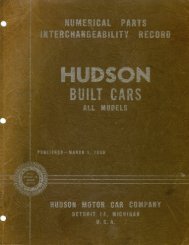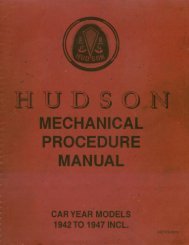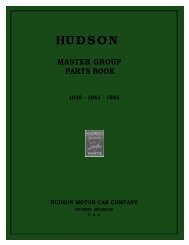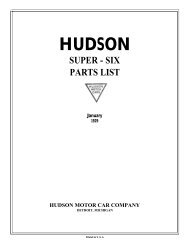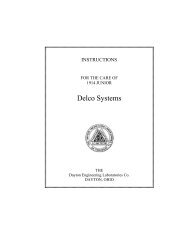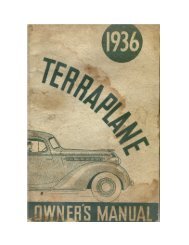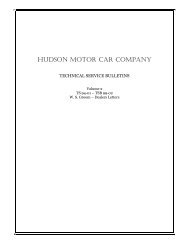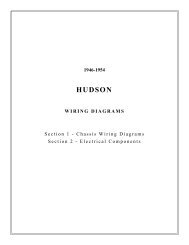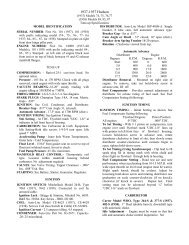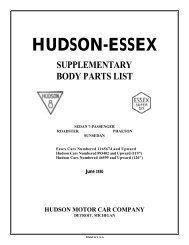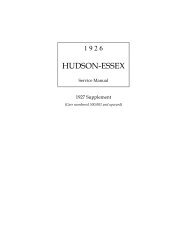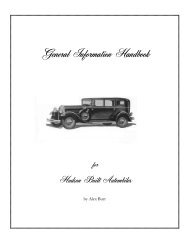1948-1952 Shop Service Manual - - Hudson-Essex-Terraplane Club
1948-1952 Shop Service Manual - - Hudson-Essex-Terraplane Club
1948-1952 Shop Service Manual - - Hudson-Essex-Terraplane Club
You also want an ePaper? Increase the reach of your titles
YUMPU automatically turns print PDFs into web optimized ePapers that Google loves.
4 - 32 FUEL SYSTEM & EXHAUST<br />
diaphragm (I) up against the diaphragm spring (J), expelling<br />
air through the outlet valve (K) and port (L) into the<br />
manifold.<br />
With the cam lever on the low side of the eccentric, spring<br />
pressure forces the diaphragm down, drawing air from the<br />
windshield wiper through the inlet port (M) and valve (N).<br />
When the manifold vacuum increases, the diaphragm is<br />
drawn up against the spring and ceases to operate. The<br />
diaphragm operates only when manifold vacuum is insufficient<br />
for wiper operation.<br />
FUEL PUMP TEST:<br />
1. Remove and clean the fuel pump sediment bowl and<br />
screen.<br />
2. Replace the screen if damaged.<br />
NOTE: If the combination fuel and vacuum pump is used,<br />
remove and clean the air filter screen located under the<br />
cover at the top of the pump.<br />
3. Make sure all connections and cover screws are tight after<br />
replacement.<br />
4. Disconnect the fuel line at the carburetor and connect the<br />
fuel pump gauge.<br />
5. Start the engine and run at 1800 RPM. Pressure should<br />
be 3 to 4 pounds with AC combination fuel and vacuum<br />
pump and 3-1/2 to 4-1/2 pounds with Carter M-729SZ.<br />
Stop engine and watch pressure gauge. Pressure should<br />
not fall perceptibly.<br />
6. If pressure falls, leaking pump valves are indicated.<br />
7. If pressure is below specifications, attach vacuum gauge<br />
to inlet port of pump and operate engine. Gauge should<br />
show 6" of mercury or higher for satisfactory operation.<br />
8. If fuel pump pressure is low, but vacuum reading<br />
satisfactory, difficulty is in the gasoline tank or lines<br />
to the pump.<br />
9. If pump pressure and vacuum are both low, pump should<br />
be repaired or replaced.<br />
VACUUM BOOSTER TEST:<br />
To check the action of the vacuum portion of the combination<br />
fuel and vacuum pump, connect a vacuum gauge to<br />
the inlet port and disconnect outlet. Gauge should show<br />
8-1/2" of mercury at 120 RPM and 12" at 1800 RPM. If<br />
vacuum is not within these limits, repair or replace pump.<br />
REMOVAL (8 Cylinder):<br />
1. Remove right front wheel.<br />
2. Remove rear portion of fender dust shield.<br />
3. Disconnect fuel lines from pump.<br />
4. On combination pump, disconnect vacuum lines.<br />
5. Remove cap screws, pump, and gasket pack.<br />
REMOVAL (6 Cylinder):<br />
1. Disconnect fuel lines from pump.<br />
2. On combination pump disconnect vacuum Lines.<br />
3. Remove cap screws, pump, and gasket pack.<br />
Installation:<br />
Install in reverse of removal. Make sure flange gasket (A),<br />
Figure 105, mounting stud insulator bushings (C) and washers<br />
(E) arc placed as indicated in exploded view.<br />
FUEL PUMP OVERHAUL<br />
NOTE: New diaphragms should be dipped in kerosene to<br />
soften them before assembly.<br />
FUEL PUMP DISASSEMBLY (CARTER):<br />
1. Mark pump body and valve housing with a file to insure<br />
correct reassembly.<br />
2. Remove cam lever return spring (F), Figure 105.



